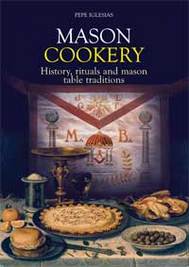Mason cookery

Content Index
Work Plan
- Studies on Masonic Cuisine
- Something about masonry without gastronomy
- Gastronomy as a cultural expression and a method of historic study
- Phases of gastronomy
- What am I trying to show in this book?
- Final argument and the metaphor of the stairs
1. Masonic History and its Gastronomy
- 1.1. Brief masonry history
- 1.2. The alimentation of the different religions
- 1.3. The oriental cuisines
- 1.4. India, Persia and its derivations towards the west
- 1.5. The Hippocratic diet and the seven cooks of Greece
- 1.6. The cuisine of the Collegiae
- 1.7. Spanish Cuisine
- 1.7.1. Sephardic cuisine
- 1.7.2. The Mozarab cuisine
- 1.7.3 Camino de Santiago's Cuisine
- 1.7.4. Hispano-American cuisine
- 1.8. The Cuisine of the speculative masonry
2. The Fast
- 2.1. The stimulating function of the fasts
- 2.2. Masonic Fasts
- 2.2.1 Fasts for reflection
- 2.2.2. Purification fasts (Homeostasis)
3. The Festive Boards
- 3.1 The Masonic Festive boards.
- 3.1.1 Solstice Festive boards
- 3.1.2 Equinoctial Festive boards
- 3.1.3 Initiation Festive boards
- 3.1.4 Exaltation Festive boards
- 3.1.5 Feast of a new Lodge ignition of Lights
- 3.1.6. Family celebrations
- 3.2. The Toasts
- 3.2.1. Obligatory toast
- 3.2.2. Free toasts
- 3.2.3. The Retiling toast:
- 3.2.4. In funeral gatherings
4. The Cenacle
- 4.1 The Energies of the cenacle
- 4.1.1. Location
- 4.1.2. Decoration
- 4.1.3. The Illumination
- 4.2. The table: assembly and protocol
- 4.2.1. The vacant seat
5. Esoteric Study of the Products
- 5.1. Drinks and Libations
- 5.1.1. Which Drinks to Have and Which to Repudiate?
- 5.1.2. How to Carry Out Libations?
- 5.1.3. Which aims should we drink for?
- 5.2. Animal Sacrifice
- 5.3. Vegetable Harvest
- 5.4. Energetic Feeding
- 5.4.1. The Principles of Energetic Food
- 5.4.2. Macrobiotics
- 5.4.3. Vegetarianism
- 5.4.4. The Mediterranean Diet
- 5.5. Sacred Foods
- 5.5.1. Olive Oil, the Liquid Gold from the Mediterranean
- 5.5.2. Rice, Manna for the Eastern
- 5.5.3. The horse for the astures
- 5.5.4. The Sacred Meat of Christianity
- 5.5.5. Honey, ambrosia and nectar of the gods
- 5.5.6. The Goose for the Jars
- 5.5.7. The Bread
- 5.5.8. The Salt, Exorcist and Fraternal
- 5.5.9. The scallops, the ‘concheiros’ and the ‘kjiokenmöddings’
- 5.5.10. The Christian wine
- 5.6. Foods for the spirit
- 5.7. The symbol system of the foods
- Esoteric Glossary of the Foods
6. The cookery ritual
- 6. 1. The importance of the ritual
- 6.2. The transmission of the chef
- 6.3. Techniques of ritual cooking
- 6.3.1 Facilities
- 6. 3. 2. The Utensils
- 6.3.3. The cooking of dishes
- 6.3.4. Forms of presentation
7. Introduction to the recipe book
- 7.1 Starters
- 7.2. Fish
- 7.3. Meats
- 7.4. Desserts
- 7.5. Libations
8. Masonic menus
For learn more, click in Mason cookery. History, Rituals and Mason Table Traditions












